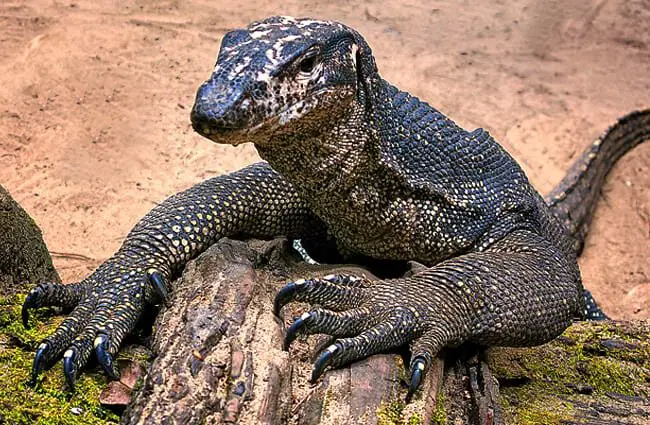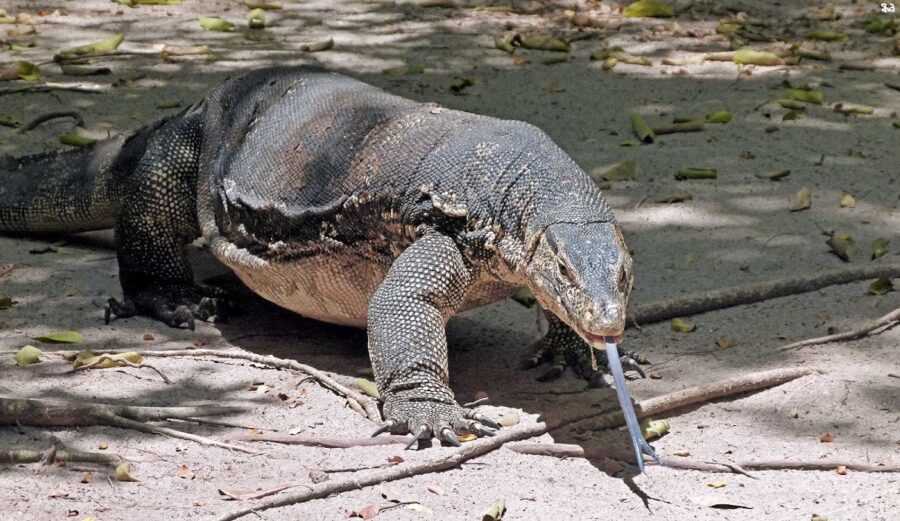With its sleek and muscular body, the Asian Water Monitor is perfectly adapted for its water-based lifestyle. Its long, powerful tail helps it to swim effortlessly through the water, while its strong limbs and sharp claws enable it to climb trees and even walls with ease.
This tropical reptile is covered in striking scales that provide protection from predators and help regulate its body temperature. The scales are a beautiful mix of colors, ranging from shades of brown, green, and black, which allow the Asian Water Monitor to blend seamlessly into its natural environment.
Despite its name, the Asian Water Monitor is not limited to aquatic habitats. It can thrive in a wide range of ecosystems, including forests, grasslands, and even urban areas. This adaptability is one of the reasons why it is one of the most widespread lizard species in Asia.
Known for its intelligence and curiosity, the Asian Water Monitor is often observed investigating its surroundings and interacting with other animals. Its diet consists mainly of small mammals, birds, fish, and even carrion, making it an opportunistic hunter and scavenger.
Discover the Asian Water Monitor: The Largest Lizard Species in Asia

The Asian Water Monitor is the largest lizard species found in Asia. This impressive reptile is known for its size, reaching lengths of up to 9 feet and weighing up to 200 pounds. With its long, muscular body and powerful legs, the Asian Water Monitor is highly adapted for its semi-aquatic lifestyle.
The Asian Water Monitor is a carnivorous lizard, meaning it primarily feeds on other animals. Its diet consists of small mammals, birds, reptiles, fish, and even carrion. With its sharp teeth and strong jaws, it can easily capture and devour its prey. To aid in catching and consuming larger prey, the Asian Water Monitor has a forked tongue that helps it detect scents in its environment.
One of the most distinctive features of the Asian Water Monitor is its large, flat scales. These scales provide protection and aid in locomotion both on land and in water. They also serve as a defense mechanism, making it difficult for predators to bite through to the flesh. In addition to its scales, the Asian Water Monitor has a long, powerful tail that it can use as a weapon if threatened.
Despite its impressive size and ferocious appearance, the Asian Water Monitor is generally a shy and elusive creature. It prefers to avoid humans and will flee if approached. However, if cornered or threatened, it will not hesitate to defend itself using its sharp claws, powerful bite, and tail.
Overview of the Asian Water Monitor
The Asian Water Monitor is the largest lizard species found in Asia. It is a formidable predator with a strong and muscular body covered in scales. This reptile is known for its carnivorous diet and can be found in various tropical habitats throughout Asia.
One of the defining characteristics of the Asian Water Monitor is its size. It can grow up to 7 feet long and weigh over 100 pounds, making it one of the largest lizards in the world. Its long, slender body is covered in rough, overlapping scales that provide excellent protection and help it to navigate through its environment.
The Asian Water Monitor is well-adapted to its aquatic lifestyle. It has powerful legs and a strong tail, which allows it to swim efficiently in both freshwater and saltwater habitats. It is also a skilled climber and can often be found basking in the sun on tree branches or rocks near water sources.
This lizard is a solitary creature and is most active during the day. It is a skilled hunter and feeds on a variety of prey, including fish, frogs, birds, and small mammals. It has sharp teeth and a powerful bite, which it uses to incapacitate its prey.
The Asian Water Monitor has a well-developed sense of smell and can use its forked tongue to ‘taste’ the air, helping it to locate potential prey. It is an excellent swimmer and can stay underwater for extended periods, using its long, muscular tail to propel itself through the water with ease.
Overall, the Asian Water Monitor is an impressive and fascinating reptile. Its large size, carnivorous diet, and adaptability to various habitats make it a unique species in the Asian ecosystem.
Habitat and Distribution

This carnivorous predator prefers to inhabit a variety of habitats, including forests, grasslands, wetlands, and even urban areas. It displays a remarkable ability to adapt to different environments, which has contributed to its widespread distribution.
One of the defining features of the Asian Water Monitor is its elongated body covered in tough, protective scales. These scales provide it with protection from predators and help it to retain moisture in its body, making it well-suited to its semi-aquatic lifestyle.
This lizard species is a powerful predator, using its strong jaws and sharp teeth to capture and consume a variety of prey, including fish, birds, small mammals, and eggs. Its forked tongue and keen sense of smell help it to locate potential food sources.
The Asian Water Monitor is highly adaptable and has successfully colonized various regions, demonstrating its ability to survive and thrive in diverse habitats. However, habitat loss, illegal hunting, and the pet trade pose significant threats to its population, making conservation efforts crucial for the long-term survival of this remarkable lizard.
Behavior and Adaptations
The Asian Water Monitor is a large lizard species that belongs to the Varanidae family. It is known for its impressive size, reaching lengths of up to three meters. This reptile has a long, muscular body covered in scales, which provides it with protection and allows it to navigate through various terrains.
As its name suggests, the Asian Water Monitor is primarily found in tropical regions of Asia, where it can be spotted near rivers, lakes, and other water bodies. It is a skilled swimmer and can dive for long periods, making it a formidable predator in aquatic environments.
This lizard has a remarkable set of adaptations that allow it to survive in its native habitat. Its strong muscular limbs and long, powerful tail enable it to move swiftly both on land and in water. The web-like structure between its toes aids in swimming, while its sharp claws help it climb trees and grasp prey.
The Asian Water Monitor is a carnivorous predator, with a diet consisting mainly of small mammals, birds, fish, and eggs. It has a keen sense of smell, which helps it locate food sources in its environment. Once it has located its prey, this lizard uses its strong jaws and sharp teeth to capture and consume it.
Defensive Mechanisms
In addition to its hunting abilities, the Asian Water Monitor has several defensive adaptations that allow it to protect itself from potential threats. When threatened, it can inflate its throat to appear larger and more intimidating. It also has a powerful tail that it can use to whip attackers and inflict painful blows.
This reptile has excellent vision and can detect movement from a significant distance, allowing it to detect potential dangers. If approached by a predator, the Asian Water Monitor can quickly retreat into the water and swim to safety.
Communication
The Asian Water Monitor communicates using a combination of visual signals, body language, and vocalizations. It has been observed displaying aggressive behavior towards intruders by hissing, inflating its throat, and striking with its tail. Males also engage in combat during the mating season, where they wrestle and attempt to dominate one another.
| Scientific Name | Varanus salvator |
|---|---|
| Size | Up to 3 meters in length |
| Habitat | Tropical regions of Asia, near water bodies |
| Diet | Small mammals, birds, fish, and eggs |
| Conservation Status | Least Concern |

I’m Lena Adams—a product of an unconventional upbringing in the African wilderness. My father, a daring explorer of African wildlife, sparked my fascination with reptiles, a passion that intertwined with the tragic loss of my mother during an expedition, leaving an indelible mark on my life. Driven to understand the creatures that captivated my parents, I embarked on my journey, sharing insights about reptiles, frogs, and lizards on my website. Through my explorations and conservation efforts, I honour my family’s legacy while seeking connections—to the creatures, nature, and the mother whose presence I yearn to understand.
